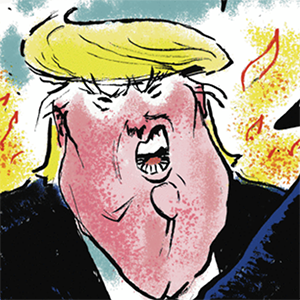Idaho braces for severe wildfire season amid funding concerns
Published in News & Features
BOISE, Idaho — It’s only June, but the outlook is grim for this year’s fire season.
Much of the Northwest is in drought. Idaho’s snowpack has melted faster, brush has been drier and temperatures have been higher than usual, said Jim Wallmann, a meteorologist at the National Interagency Fire Center. Weather experts have seen these conditions before, ahead of some of the state’s worst fire seasons, Wallmann told state officials at a Land Board meeting.
Wallmann and Josh Harvey, the chief of fire management for the state’s Department of Lands, fear this fire season will rival last year’s, when hundreds of thousands of acres burned in more than 300 wildfires and cost Idaho about $60 million. But this summer, the state has less money set aside than in June 2024 to pay for it.
Members of the Land Board, which directs the Department of Lands’ management of over 2.5 million acres of Idaho’s endowment trust lands, sought to refill the account and set up ongoing contributions to the fund. Instead, state lawmakers approved only a one-time addition of $40 million.
That amount may well be insufficient, Gov. Brad Little wrote in April — while signing off on the decision.
“Simply put, if we have a bad fire year, the amount the Legislature appropriated for fire suppression will not be enough to cover the bills for the fires the state is responsible for,” he wrote in his transmittal letter, as he signed the bill that allocated the funding.
Idaho now has about $65 million in its fire suppression account, compared with $76 million in June 2024. The amount the state sets aside for that account changes each year, based in part on predictions of fire seasons’ severity.
If the state runs out of money to pay for wildfires, officials will need to use a mechanism called “deficiency warrants” to make up the difference. It would essentially put the spending on a credit card, which lawmakers would need to figure out how to pay during the 2026 legislative session.
“I am firmly on the record that the days of putting wildland fire suppression costs on a credit card are behind us,” Little said in his April letter.
These days, with longer fire seasons and hotter, more intense fires, fighting fires has gotten more expensive, Little told the Idaho Statesman in an interview. The state already spends about $15 million just on fixed costs for equipment and temporary firefighters, he said.
Fighting wildfires has long been a collective effort, with firefighting resources shared among states and even countries. But as Idaho competes with other states for that shared pool of firefighters, equipment and other firefighting resources, not having all the money in the bank could leave the state at a disadvantage, Little said.
In states that have money for fire suppression readily available, contractors may be more confident that they’ll be paid on time. That can make a difference in Idaho’s ability to secure those resources, as well as the prices contractors charge the state for firefighting services and equipment, Little said.
“The certainty of knowing the funding is there means it’s going to be a better deal for the taxpayers of Idaho,” he said.
Idaho fire chiefs and the state’s Department of Lands director in February vied for the Legislature to fully fund fire suppression.
“Debt financing fire suppression leaves state and local fire managers like us in the undesirable position of telling our people on the front lines that there is uncertainty whether the funding will be there to pay the bills at a later date,” they wrote in a statement published on the Idaho Department of Lands website. Putting millions on a credit card, they wrote, is “flat irresponsible.”
Idaho House speaker: Don’t turn fire funding into a ‘piggy bank’
House Speaker Mike Moyle, R-Star, agreed that using deficiency warrants to pay for fire suppression had downsides — but he said officials were overstating the likelihood of needing to use them.
Moyle pointed out that in 2024, with about $60 million in the state’s fire suppression account, Idaho was prepared to cover the costs of a bad fire year.
“I think you had an abnormally large year of fire, in regards to the fires last year,” Moyle said. “We left enough in (the account) to pay for another large fire year like last year.”
He highlighted the opportunity cost of filling the account beyond that point, using money that could otherwise be spent on education, tax cuts or other purposes.
Lawmakers “wanted to make sure that we just don’t turn it into a piggy bank where the money just goes there and sits,” he said. “To have an ongoing stream going into that account when you don’t even know whether or not you need it there, it just doesn’t seem prudent, right?”
Little acknowledged that lawmakers had competing priorities. He told the Statesman he believes Idaho is still prepared for the coming fire season. Even using deficiency warrants, Idaho remains in a better position than some other states, such as Oregon, that have to call special legislative sessions if they need to exceed their fire suppression budget.
But at the Land Board meeting, he was more blunt.
“The Legislature, through the appropriations process, saw fit to give us less than what we need,” he told Land Board members.
Longer fire seasons, DOGE cuts challenge firefighting
The world of wildland firefighting is changing, Land Board members said.
At their June meeting, they raised concerns about the federal government’s decision to offer early retirement to workers at the Bureau of Land Management and the U.S. Forest Service, as part of an effort by the so-called Department of Government Efficiency to slash the federal budget.
That push has led to the retirement of some of the departments’ most experienced staff in what The Washington Post dubbed a “federal brain drain.”
BLM and the Forest Service didn’t lay off any emergency firefighters, Little told the Statesman, but they lost many of their most experienced staffers who help to secure resources during large firefighting projects.
Those losses “are all concerning, and we don’t know exactly what those gaps are until they’re going to be upon us this season,” Julia Lauch, Idaho’s state forester, told Land Board members.
“We will continue to communicate and coordinate with our partners to ensure that we’re leveraging the limited resources that are available for the best use, and keeping the firefighters as safe and supported as possible, and thinking creatively to fill the gaps where we can,” she said.
The industry is also going through a “reckoning,” said Secretary of State Phil McGrane, a Land Board member. Wildland firefighting used to be a short-term, well-paying seasonal job — but that’s changing as wildfire seasons grow longer and more intense.
“This was a really attractive job,” he said at the Land Board meeting. “It’s less attractive these days.”
Little echoed some of those concerns to the Statesman. Years ago, many firefighters were college students on summer break and planning to return to school in late August.
These days, fire season is in full swing right around then, he said.
“I’ve stated over and over, I want to know what our fire resources are going to be on the 25th of August,” he said. “That’s usually the peak of the fire season. The days are still hot.”
“We had lots of fires last year at that point in time. What are my state resources going to be?” Little added. “What are the BLM resources, the federal resources — and in fact, what’s the fire situation everywhere?”
©2025 The Idaho Statesman. Visit idahostatesman.com. Distributed by Tribune Content Agency, LLC.







Comments